A lot of my patients ask me whether a facelift is the best option to maintain youthful skin. While it is certainly true that facelifts can help reduce the signs of ageing, there are many variations to the treatment! It is important to know what each procedure entails and what they may help you achieve in the long run.
I have trained other doctors on the procedures you will see later on, having done too many of them to count. So I have written this article to discuss the different types of facelifts available in Singapore. Read on to find out more on the different types, functions, and their costs!
What is a facelift?
Here you can watch my video where I perform the Ultraformer HIFU facelift procedure on my patient
"Facelift" is the umbrella term for a range of different treatments aimed at tackling ageing signs. Each procedure aims to tighten loose skin or reposition facial tissues. With the right combination of treatments, you can achieve a more youthful look.
As you get older, you lose volume in the underlying structures that support your face due to fat, muscle, and bone changes. These changes result in:
- Sagging faces
- Droopy mouths
- Hanging skin
- Fat under the chins, and in your necks
A facelift is a cosmetic procedure that aims to help you fix these issues. The procedure consists of tightening loose skin and repositioning your facial tissues to give you a more youthful look.
Will it be obvious that you had a facelift?
The results are often dependent on the skill of the doctor you choose. A facelift can be anything from very obvious to incredibly subtle. It is your doctor’s main objective to make the results as natural as possible.
If your skin displays very serious signs of ageing, it will be noticeable because there will definitely be improvements to your overall appearance.
How much do facelifts costs in Singapore?
The price would depend on the targeted area and also the clinic you choose to visit. You can see the table below for the estimated price of the different facelifts in Singapore dollars.
Type
Estimated Price in Singapore
Targeted Concern
Surgical Facelifts
Mini facelift
From $10,000
Mild sagging skin
Full facelift
From $40,000
Severe sagging skin. Jaw, cheeks, nose, forehead
Non-Invasive Facelifts
Radiofrequency
Thermage
$2,800-$7,000
Only for mild sagging and laxity
Endymed
$500-$3,000
Only for mild sagging and laxity
Microneedle radiofrequency
Intensif
$1,500-$3,000
Wrinkles, sagging, loose skin
Agnes
$1,500-$4,500
Fine lines, wrinkles, sagging jowls, eyebags, double chin
HIFU
Ultherapy
$640-$2,000 (Smaller areas)
$2,000-$6,000
(Full-face)
Facial and upper neck sagging
Ultraformer
$500-$4,500
Facial, neck and body sagging
Laser
Fotona Smooth/PIANO/4D
$800-$4,500
Eyebags, Full face, neck and body sagging
Long-pulsed ND: Yag
$300-$1,000
Dark eye circles, wrinkles, mild and moderate sagging
Minimally-Invasive Facelifts
Dermal Filler
$600 - $1,800
Any affected area (usually sunken areas)
$1,000 - $7,000
Whole face, jaw, neck
Nefertiti Lift
$300-$1,500
Jaw, neck
As mentioned earlier, do consult a doctor to see which type is more suitable for you. You can also get treatment quotes from multiple clinics by clicking here.
Related: Everything You Need To Know About Non-Surgical Facelifts in Singapore: Cost And Comparison
Are you suitable for a facelift?
The facelift procedure is relatively straightforward. However, not everyone will get great results from a facelift. A successful facelift depends on 3 key factors:
Good skin elasticity - During the procedure, your skin will be tightened to smooth out wrinkles. Successful healing will depend on your skin’s ability to adjust to its new contours. You will heal well and get better results if you have supple and flexible skin.
A strong bone structure - When you have a good bone structure, it will help you achieve better results because it provides sufficient support to your skin. If your bone structure is weak, you may want to consider using fillers along with the facelift or as an alternative to improve it.
Loose, excess skin around your neck, jawline, or midface - The goal of a facelift is to remedy skin laxity on your face. If you don’t have excess skin in those areas, your concerns might be better addressed by other treatments.
For surgical facelifts, you must be a non-smoker as smoking can increase complications after the procedure.
What are the types of facelifts in Singapore?
Broadly, facelifts are split into 2 different types: surgical treatments and non-surgical treatments.
What are the surgical facelifts available in Singapore?
These are invasive treatments that involve an incision. From there, the surgeon will separate your skin and tissue, then reposition them. There are 2 types of surgical facelifts, mini-facelifts and standard facelifts [1].
Before I share with you more on these two options, there are a few disadvantages you might want to take note of for either facelift options:
- Higher cost
- Higher risk of complications such as stroke and heart attack
- Longer treatment time, about 2 – 4 hours per treatment
- Longer recovery time, at least 2 – 4 weeks required
- Greater risk of dramatic over or under-correction
- Highly dependent on the skill and aesthetic views of the surgeon
Mini-facelifts
These are less invasive procedures with cuts that can be made in more discrete locations, such as around the ear. The main distinguishing feature of a mini-facelift is that the scar left behind is shorter. This is suitable for those with less extensive issues, such as mild jowls and saggy skin.
For this kind of surgery, you can be given either a local or general anaesthesia, so you can choose to be conscious while the surgery happens.
Standard facelifts
This is a more extensive version of the mini-facelift. The scar made will be longer as more extensive cuts have to be made.
While standard facelifts can be used to treat more minor issues, like the aforementioned jowls and saggy skin, this option is preferred for moderate to severe ageing signs around the face and neck. The results can result in a dramatic and noticeable difference in looks.
In most cases, surgical facelifts are corrective. They are used to treat rather than prevent the signs of ageing. It is suitable for those who want a dramatic change in the shortest time possible.
Don't be mistaken, the results from a facelift are also not permanent since even after repositioning, sagging can and will happen again. As I like to tell my patients, ageing is inevitable, and nothing is permanent in the world!
Non-surgical facelifts—the least downtime!
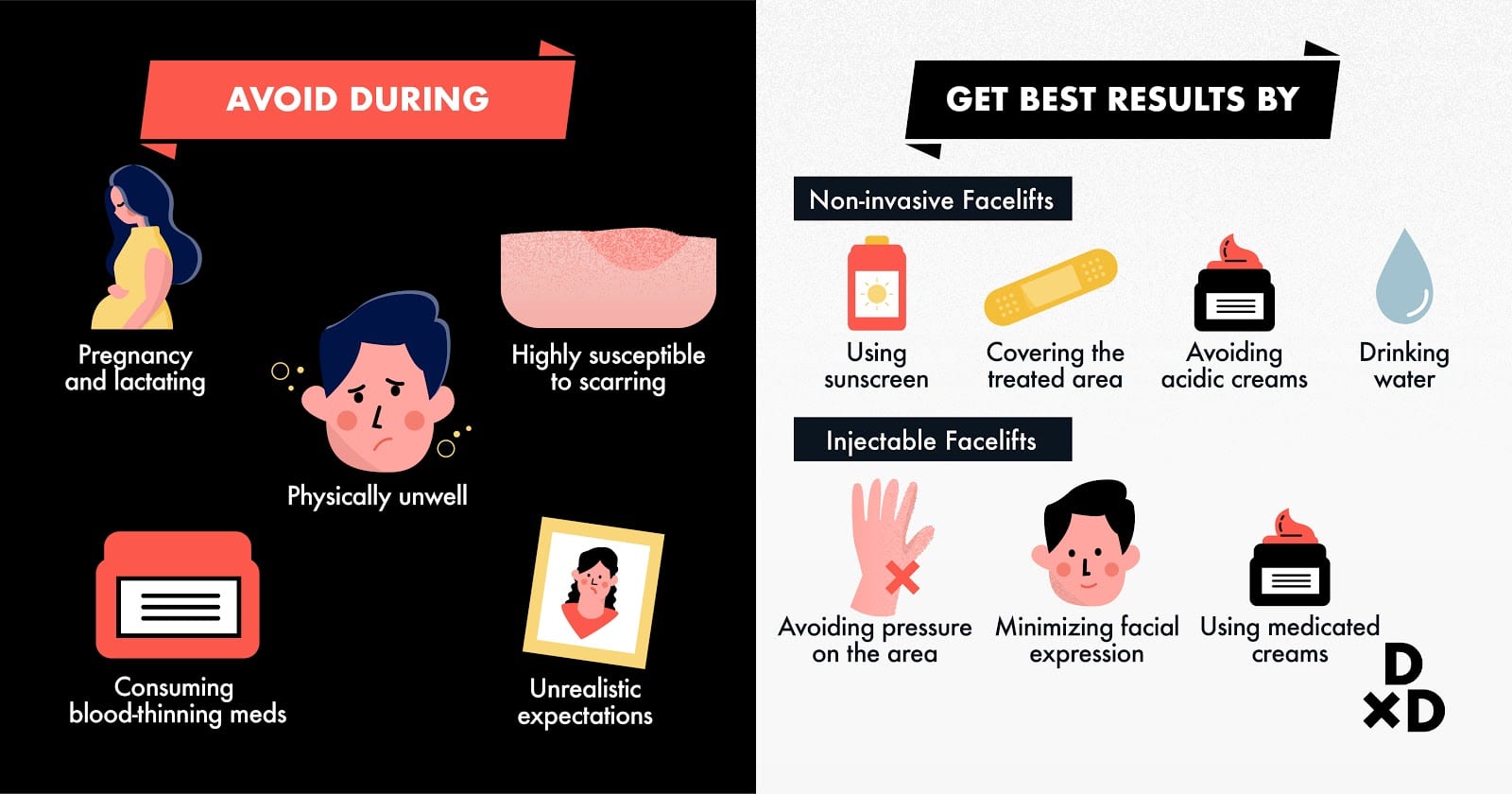
These days, non-surgical facelifts are more common. This is because it can be done very quickly and also requires little to no downtime. In most cases, you can go back to normal activities within a few hours. [2]
They are split even further into 2 subgroups: non-invasive vs minimally-invasive treatments.
Read more: An Aesthetic Doctor's Complete Guide To Non-Surgical Facelifts In Singapore (2021)
What kind of non-invasive facelifts are there in Singapore?
They are the exact opposite of surgical facelifts, meaning these types of facelift do not involve incisions. There are a few types depending on the technology they use. This includes:
- Radiofrequency (Thermage, Endymed)
- Microneedle radiofrequency (Intensif, Agnes)
- HIFU (Ultherapy, Ultraformer)
- Laser (Fotona Smooth, Fotona PIANO, Long-pulsed ND: Yag lasers)
Related: Thermage, Ultherapy & Dysport Dermalift In Singapore: Cost & Comparison (2021)
They are suitable for those who desire a more natural result. The treatment methods offer a subtle and gradual correction over a longer period of time. You can find the advantages and disadvantages of non-invasive facelifts in the table below:
Advantages of non-invasive facelifts
Disadvantages of non-invasive facelifts
Lower cost
May need multiple sessions over a longer period of time
Minimal side-effects
Poor operators may not deliver any results
Fuss-free and shorter treatment time
“Imperfect” non-dramatic results
Gradual skin tightening with continuous improvement over time
Other risks depending on the device used (redness, swelling, pigmentation, etc.)
What you should know about the different face-lifting devices
Each type of device works differently and targets a different skin concern/layer. They also come with their own sets of side-effects. The broad categories are:
Bulk heating devices - Radiofrequency and laser devices currently mostly rely on bulk heating to achieve a collagen stimulation response in the different face layers, with the aim of immediately tightening loose tissue and improving the strength of supporting tissues in the long run.
Popular devices include Thermage, Exilis, Endymed for RF devices, and Fotona, Candela and Excel V for laser devices.
Targeted layer treatment devices - HIFU and microneedle RF devices provide a targeted treatment at predetermined depths and settings of the device used. Ultherapy and Ultraformer are prominent HIFU devices, while AGNES, Infini and Intensif are well-known microneedling RF devices.
Most lifting devices have similar common and mild side effects such as:
- Mild discomfort, usually during and after the treatment
- Mild swelling, especially after aggressive treatment
- Mild bruising
- Mild skin irritation or rash usually disappears within a few hours
However, their unexpected side effects are not the same as it depends on the treated area and the patient’s skin condition.
For example, if your HIFU treatment is done excessively at the wrong depth, you can get facial sunkenness, terrible burns can happen with contact RF treatments such as Thermage, and your skin colour might change if your laser treatment is not done properly. Recommendations for the appropriate face lifting device are provided later in this article.
Also read: Benefits of HIFU and how it works.
What about minimally-invasive facelifts in Singapore?
This type of treatment is the intermediate option between a non-invasive and a surgical facelift. Some popular techniques include:
- Fillers – placed at specific locations to act as support. It helps to retain existing ligaments and stimulate collagen production. They also help improve the ageing signs of sunken facial contours.
- Threadlifts – These directly hook and reposition sagging tissues. It helps to achieve a more lifted and youthful look.
The main advantages are that you will have nice, instant results without the need for surgery. You also get the bonus of gradually improving skin quality as the injectables continue to stimulate natural collagen production over time.
Related:
Filler Lifts Vs Threadlifts In Singapore: Cost And Comparison (2021)
The Expert's Guide to Nose Fillers and Nose Threadlifts in Singapore (2020)
However, there are also some disadvantages. More common side effects include bruising, pain and mild swelling. Less commonly, risks such as lumpiness, over-correction, skin damage (necrosis) and vascular embolism can happen but are much less likely in trained hands.
Results are also more dependent on the doctor’s skills and how well they understand what makes something aesthetic.
That said, all the non-surgical facelifts are generally very safe. The most important point is to find someone who is confident enough to discuss the risks instead of avoiding them, and with a lot of experience and proof of their previous patients’ success!
During your consultation, you should definitely ask the doctor for some photos of his/her previous patients.
Additionally, there are different options of injectables that you can choose [3]:
- temporary filler
- semi-permanent
What are the most popular temporary soft tissue fillers brands in Singapore?
Hyaluronic acid or HA fillers mirror the natural HA we have inside our skin. Popular brands include Juvederm, Belotero, Teosyal and Elravie. These fillers typically last for months, with subtle collagen stimulating effects. One added bonus is that they also help with moisture attraction and retention, so expect glowing skin after the treatment as well!
Then what about semi-permanent soft tissue fillers?
These fillers (including CaHA, PCL and PLLA) provide more intense collagen stimulation, and clinical studies show a much longer-lasting effect in comparison to HA fillers. Popular brands include Radiesse, Sculptra and Ellanse. Be careful though, they are harder to use and are not reversible!
What are threadlifts?
Most threadlifts are made from similar suture material used in surgeries. Threadlifts are clever inventions which allow the placement of surgical “hooks” or “meshes” from only small needle insertion points, bypassing the need for a surgical scar. Threadlifts are extremely dependent on good materials, a knowledge-based approach and good technique.
Without which, most patients would be extremely disappointed. Many practitioners who do not achieve a lift pacify their patients by saying that the results will gradually show up with time. This is completely untrue!
Threadlifts should show an immediate lifting effect - if all you wanted is a gradual skin tightening effect, machine-based treatments or collagen stimulators (see above) would suffice.
The longest-lasting, underrated facelift procedure in my opinion—Nefertiti lift
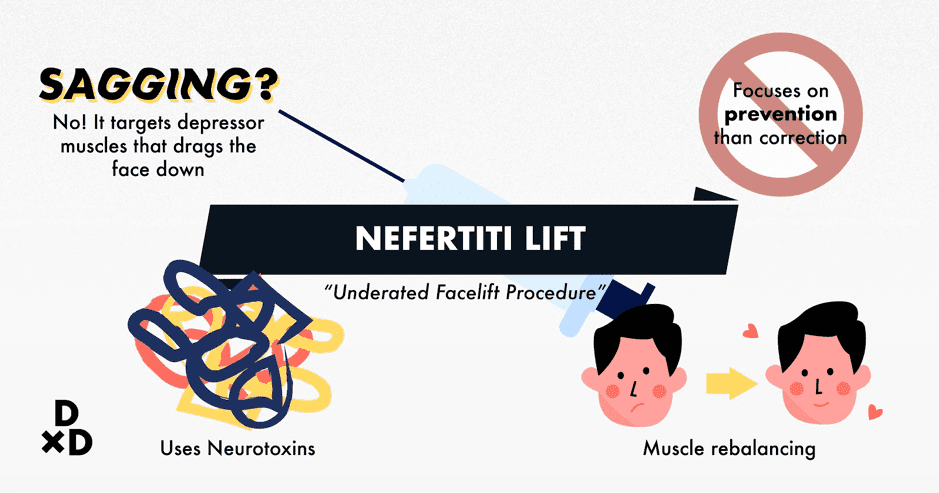
All the non-surgical facelift options mentioned earlier work mainly by correcting the signs of ageing. I would like to talk more about the “Nefertiti lift” that gives you long-lasting results. It is the only facelift method that focuses on prevention rather than correction.
The Nefertiti lift is done by using neurotoxins to re-sculpt your jawline [4]. Popular brands include Botox, Dysport and Xeomin, and they all work by relaxing muscles.
You might ask, “since they work by relaxing muscles, won’t it cause more sagging?”
In the case of a Nefertiti lift, the Botox is used to target specific muscles called the depressor muscles. Those are muscles that drag your face down. By giving them a “holiday”, your face will look more lifted.
What makes this method special is that they stimulate muscle rebalancing. With that, the results of the Nefertiti treatment become more and more long-lasting. This is the only facelift that directly prevents the cause of sagging.
How do you choose the correct type of facelift?
This depends on a few factors: [5]
- Area of concern. Smaller areas may require less extensive and invasive procedures compared to more extensive ones.
- Expected results. How long do you want your treatment to last for? Do you mind if the results are only subtle/natural or do you want a more drastic outcome?? Non-invasive treatments are usually subtle, while surgical options tend to be more drastic.
- Your medical history. Have you had certain procedures done before? Do you have any preferred treatments in mind?
I’ve listed some personal recommendations below for 4 different categories of treatments available currently.
1. Bulk heating device treatments
I’ve used multiple bulk heating devices in my career, including prominent devices like Thermage radiofrequency and Fotona lasers. Bulk devices are efficient and comfortable, making them a popular choice.
However, there is more myth than science for a lot of medical devices, which really should not be the case for a medical field.
This clinical review [6] looked through all available evidence regarding RF devices (including all the prominent ones) and concluded that RF for the treatment of skin laxity is more myth than truth based on the poor quality of all their clinical studies.
This can be explained scientifically. Radiofrequency devices use electric current to generate heat and induce tightening. The skin has a much higher conductivity than its surrounding tissues; hence RF would have the most effects only on the surface (skin) and minimal effects in the deeper layers that need tightening for a facelift effect.
Coincidentally then, higher skin conductivity also means there is a higher risk of burns before any significant facelifting effects.
Laser bulk heating devices are very different. They may select for a specific target and can affect deeper layers without overheating the skin.
VERDICT: AVOID RF devices like Thermage for facelifting—the latest evidence shows they are more myth than the truth!
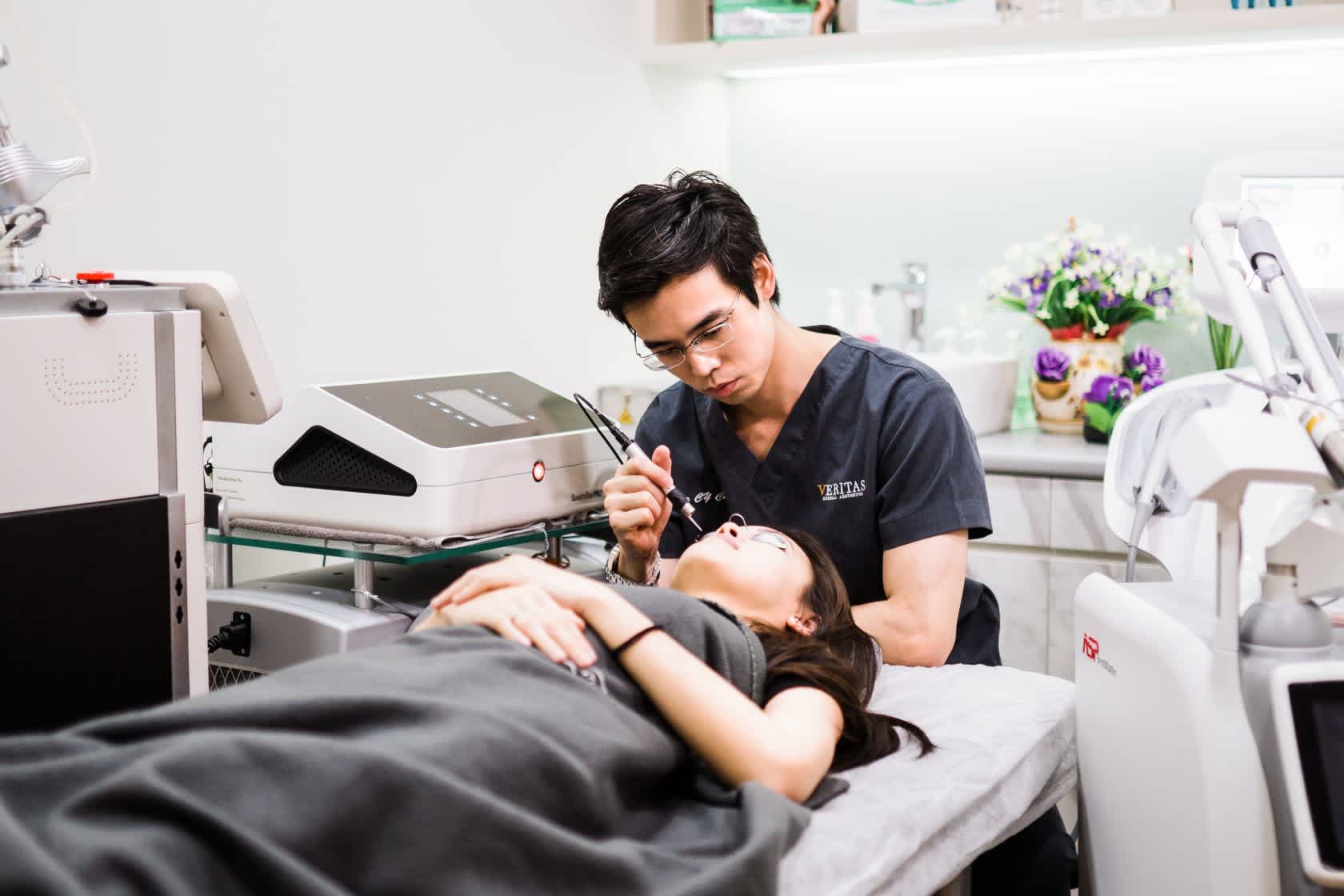
2. Targeted layer treatment devices
HIFU and microneedle RF are popular devices that target a specific layer with focused beams of energy. These devices are useful to help tighten the layers of sagging that are deeper than skin deep while minimising damage to the surface.
This does not mean they are definitely “better” than bulk heating devices. Again, I make fair comparisons because I own multiple versions of these different technologies - I’ve used the Ulthera, Ultraformer (HIFU devices) as well as the Infini/Intensif/Agnes (microneedle RF devices).
HIFU devices are one of my favourites, but people often neglect the importance of proper techniques and protocols (you can read my HIFU article here).
Microneedling RF devices are very interesting too, but having needles penetrate through multiple layers of the face can be a painful and bruising experience. Agnes is the most precise microneedling RF device like I shared in this regional conference AsiaDerma 2019.
VERDICT: Again, avoid most RF microneedling options - AGNES and HIFU options are most promising.
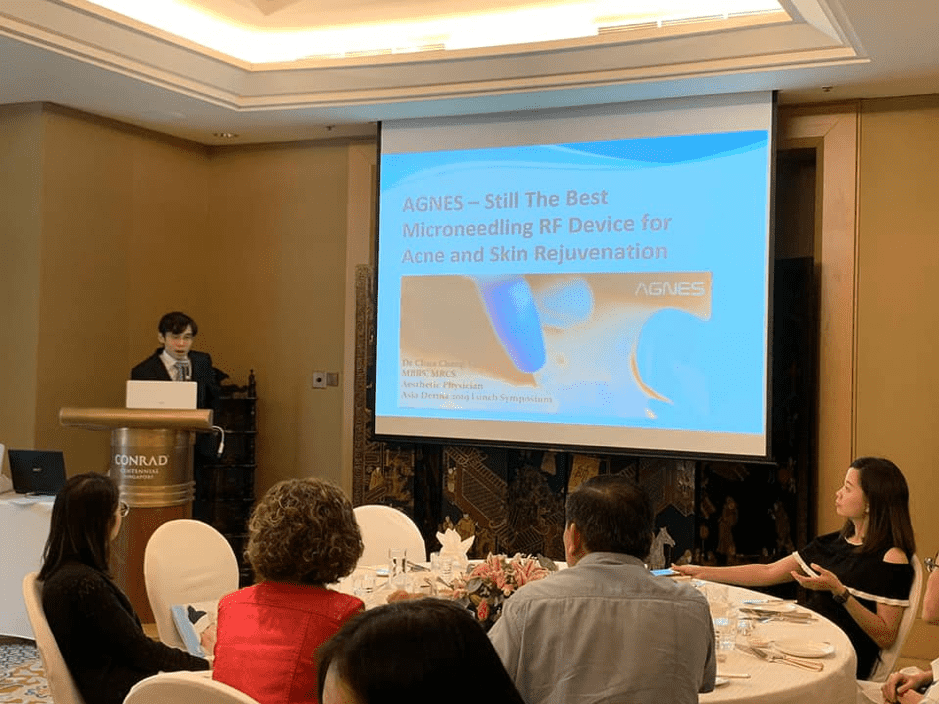
3. Filler treatments
I love filler treatments! They’re like natural surgical implants without having to go for surgery at all. I’ve had them done for my own nose, chin and cheeks just to experience the good and bad that comes with it (the bad was the discomfort and nervousness during treatment).
There are many different types of fillers, usually of different strengths and hardness - for the various layers and areas of the face. Brands can be attractive but become less important when you realise different types are needed for different areas.
Fillers can drastically improve laxity, but the downside is possible hideous side effects from too much done. Imagine if that happens with the irreversible fillers.
VERDICT: Look for experienced and balanced recommendations. An experienced injector shares his knowledge and experience freely and is usually well versed in a wide range of products.
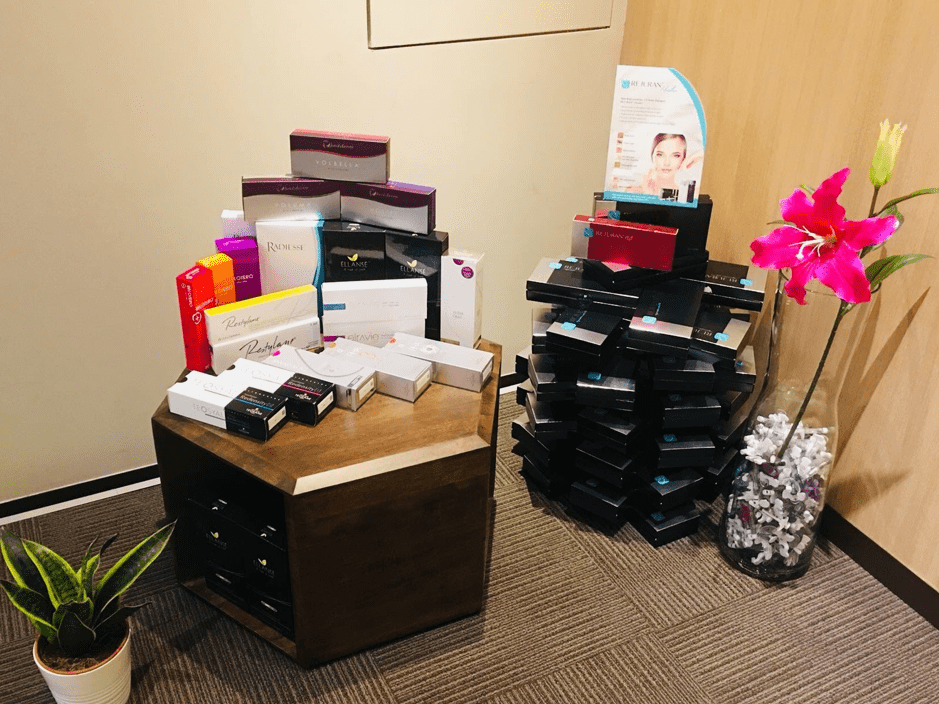
At a conference: showing participants the wide range of products such as injections
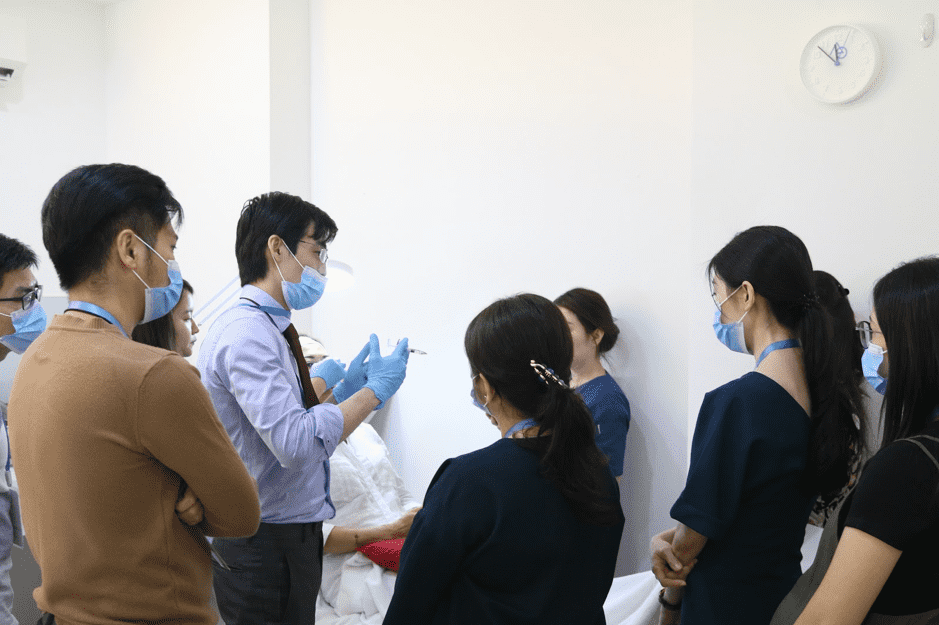
Here, I am at a training conference for Penang doctors on filler injections
4. Threadlifts
Threadlifts are **very useful for brow lifts, jowls and double chin lifting. Just like fillers, there are a few different types for different layers and areas of the face. Well-known brands include Aptos, Double Fix, N-finders and Silhouette. Ironically, many threadlifts don’t really “lift” - they only provide a gradual collagen stimulation and tightening effect.
**Some other threadlifts give a nice immediate lift, only to have the effect lost after a short few weeks! Avoid these 2 examples at all costs; they’re completely not worth it in my opinion. A good threadlift procedure may require a combination of different threads but should give immediate and lasting results.
VERDICT: I recommend Double Fix and N-finder threads for facelifting if you are looking for immediate and long-lasting results. (disclaimer: I am an international advisory board member for the Double Fix threadlift)
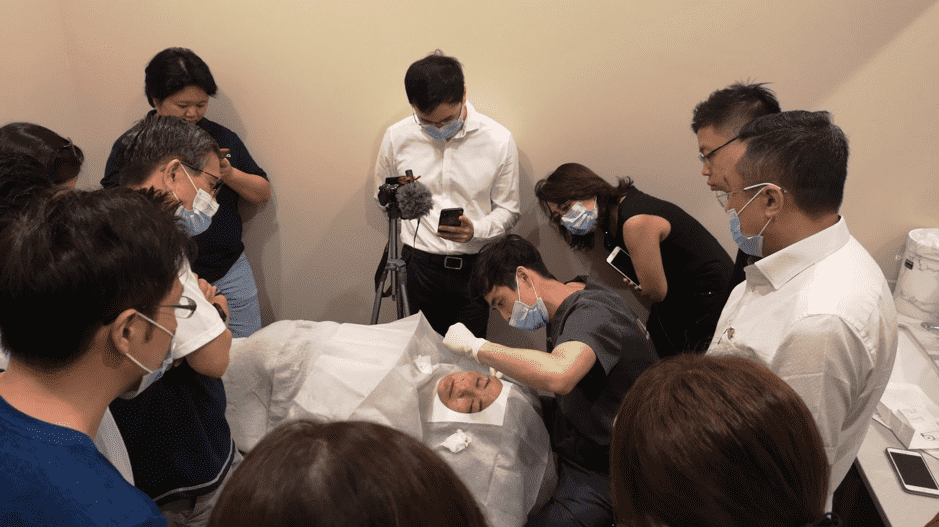
Here you can see me at a local threadlift training session - Singapore Double Fix 2019
Above all, it is best to get a consultation with a doctor before choosing any treatment. The best treatment is one that is planned specifically for you.
During the consultation, discuss your concerns and what you want to achieve from the treatment. As mentioned earlier, you can also ask the doctor for some pictures of his/her previous patients.
Also read: What are the best options for a Facelift in Singapore?
Do dermal fillers and Botox offer the same results as a facelift?
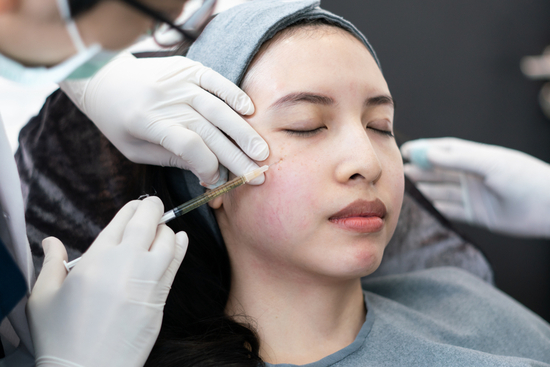
First and foremost, you need to understand that while dermal fillers, Botox, and facelifts work towards making your face look youthful, they actually target different facial concerns.
They don’t actually lift your face per se; the effect can be thought of as filling an empty balloon. I usually use them on areas of the face that has lost volume.
I would recommend dermal fillers and Botox for those of you who are younger than 50 and do not have severe sagging skin.
Dermal fillers are made from hyaluronic acid, which is naturally found in the skin. When injected into the skin, it plumps your face up and replenishes your body’s natural production of hyaluronic acid. It helps you remove your wrinkles by adding volume to your skin and smoothening it out.
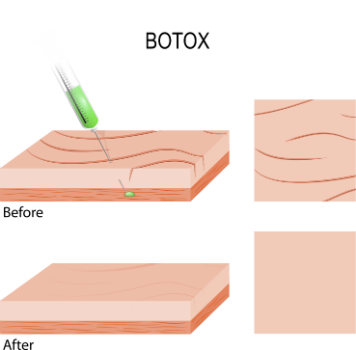
Botox is actually a drug made from a neurotoxin. After it has been injected into your skin, it “freezes” your muscle by blocking any signals to move it from your brain.
The muscle that has been injected can no longer “move”, so the overactive facial muscles relaxes and softens up. In my experience, Botox lasts for a good 4 months, and sometimes even up to 5 or 6 months.
How painful are facelifts?
If you have gone through a surgical facelift, it is very hard to reverse the results. This is one of the disadvantages I mentioned earlier as surgical treatments are, in most cases, very long-lasting.
Additionally, surgical facelifts have a longer/more painful recovery time, a higher risk of scarring, overcorrection as well as risks associated with going under general anaesthesia (such as stroke and sudden death) which can make it inconvenient and much more dangerous than non-surgical
What about side effects and unsatisfactory results for facelifts?
Cases of over or under-treatment are very rare with non-invasive facelifts. That is because it is much easier to catch and resolve any unsatisfactory results as the change is more gradual. However, we still have to make sure that the patient’s expectations are realistic in order to minimise the dissatisfaction.
Side effects with non-invasive facelifts are also usually very mild and infrequent, with the greatest side effect being the experience of slow and insignificant results, or skin burns if the wrong device/technique is used.
With minimally-invasive facelifts that involve injectables, they are mostly safe with most common side effects being temporary ones such as discomfort, swelling and bruising.
Over or under-correction can be a problem, which is why I advise all patients to go to a clinic that takes care of you with a mandatory follow up visit. This follow-up visit is essential to adjust and “perfect” your injectable treatment.
All rare and dangerous side effects of any treatment should be discussed with you as mandated by the Singapore Medical Council, but many clinics don’t tell you that injectable treatments can cause intractable pain, skin necrosis, unsightly deformities and even blindness, for fear of scaring you away from the procedure.
This is very irresponsible, especially since these clinics are also less likely to be experienced with providing such injections. ALWAYS look for somebody who discusses risks carefully with you but is confident of his/her experience in avoiding and managing those risks. It’s a bonus if they have done these treatments for themselves (hence walking the talk).
If you suffer from unsatisfactory results or side effects from a facelift, please do consult an experienced doctor to see what your options are. Let us help you find prices for treatments with aesthetic doctors.
When should you avoid getting a facelift done?
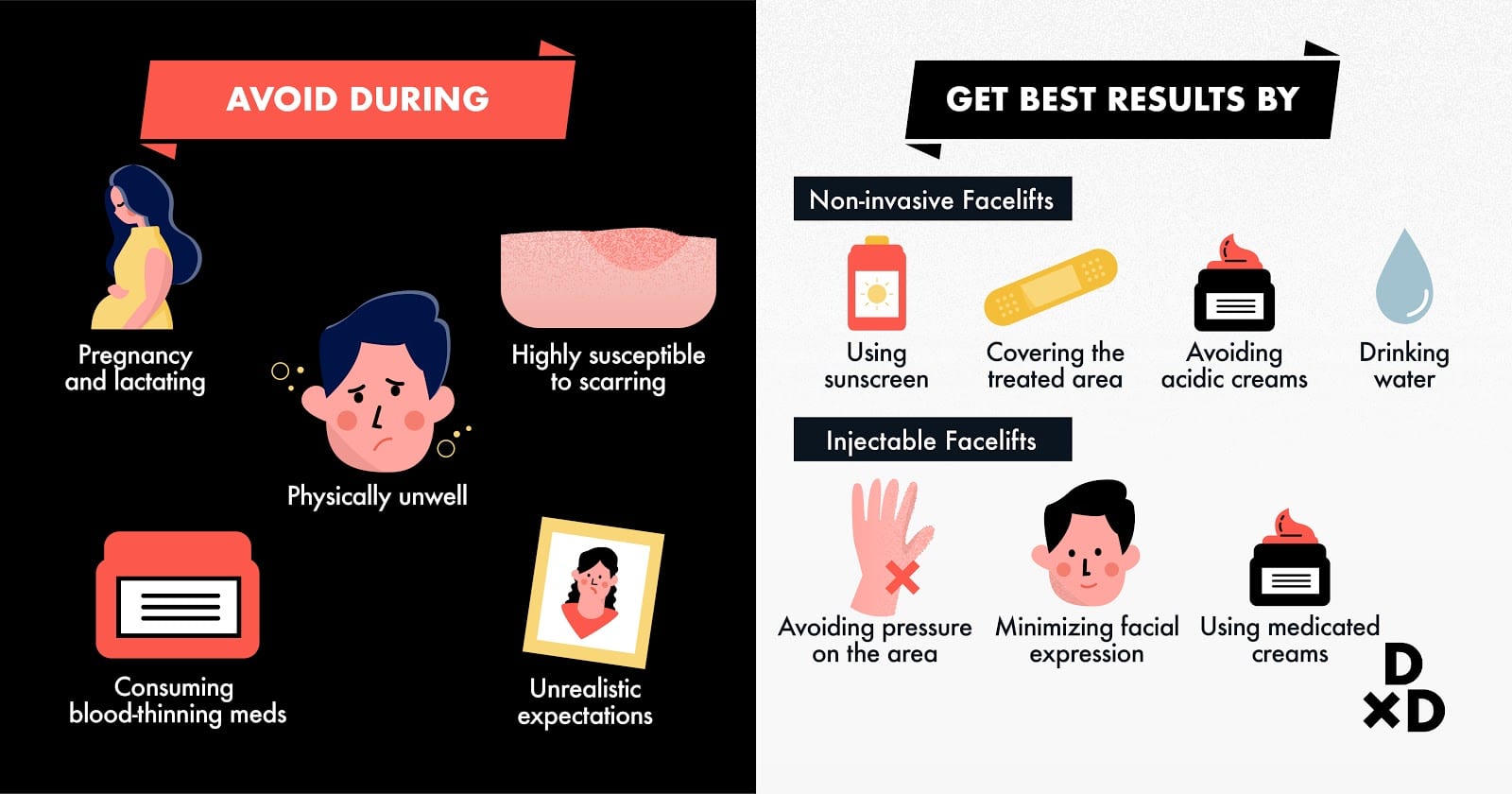
In general, non-surgical facelifts are very safe and can be done at any time. That said, you should avoid getting the treatment if you are: [7]
- Physically unwell
- Pregnant or lactating
- Highly susceptible to scarring
- Consuming blood-thinning medication (to be discussed with doctor)
- Have unrealistic expectations
There might be more contraindications depending on your condition. This is why it is important to go for a consultation before choosing any treatment. Do tell your doctor if you have any existing medical conditions to avoid any unwanted complications.
How do I get the best results after a facelift?
After getting any kind of aesthetic treatment, it is important to follow your doctor’s aftercare instructions. They are important to prevent side-effects and also ensure that you get the best results. As a general guide:
After non-invasive facelifts, you should:
- Cover the treated area as they can still be very sensitive.
- Use sunscreen to prevent pigmentation.
- Avoid acidic creams.
- Drink a lot of water to hydrate your skin and rejuvenate it from the inside out.
After injectable facelifts, you should:
- Avoid pressure or massage of the treated area
- Apply any medicated creams given
- Minimise facial expressions during the specified recovery period
How can you find the best doctor in Singapore for a facelift?
In choosing the best facelift doctor for yourself, you should take into consideration the following:
- The ability of the doctor to listen and provide an unbiased consultation
- Transparency in pricing with no hard-sell or upselling
- Credentials of the doctor and the practice
- His/her previous works to see if their aesthetic sense appeals to you
Lastly, listen to your heart and take your time to decide on the doctor and the procedure you’d like to go ahead with.
Also Read:
The Ultimate Guide to Seeing an Aesthetic Doctor in Singapore (2020)
Which doctors would you recommend for a facelift in Singapore?
Conclusion
In conclusion, there are various face-lifting methods that can help you achieve a more youthful look. Just remember, get a treatment that is most suitable for your current skin condition!
I hope that this article can help you narrow down your options. But before doing anything, I suggest you consult your trusted aesthetic doctor before proceeding with the treatment to make sure that you are choosing the right procedure.
You can click here to find prices for treatments by aesthetic doctors.
Dr Chua Cheng Yu is a frequent trainer at medical seminars. He often shares his knowledge on multiple aesthetic technologies, including the Ultraformer HIFU and Teosyal fillers. Besides that, his clinic (Veritas Medical Aesthetics) mirrors his philosophy of functional aesthetics: holistic health and beauty. Also, in his spare time, he plays the piano, dabbles with amateur photography, and maintains a personal blog.

